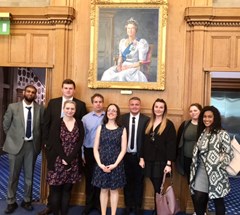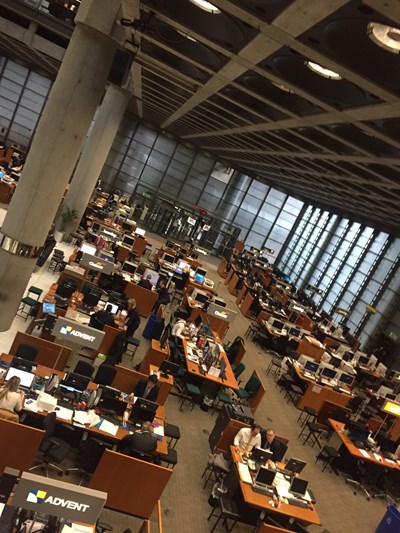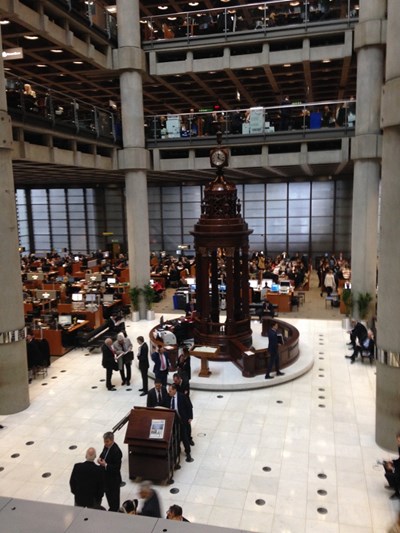Fri 12 May 2017
Lloyds Trip

Nine of us met at Piccadilly station in Manchester for this event. Just over 2 hours later we were at Euston and then to the subway towards Moorgate.
Our tour started at Lloyd's. Not the most picturesque of buildings. Modern and functional, most of the services and pipework on the outside to maximise internal space. The strict dress code, (suit and tie) was only relaxed recently, however we were hard pushed to find anyone actually break the convention.
Each wooden panel from the old library was moved to the new building and now provides an outstanding formal meeting hall from which the lunchtime sessions are presented.
Nick moved us quickly through time, from the old library to the state of the art trading floor. This is where Lloyd's syndicate business is done. Modern it may be, however the tried and tested convention of doing business still has its place. The underwriters rent space and are approached by brokers to place business with them based on the deal they can offer. Although a policy is often said to be with Lloyd's, it is only Lloyd's business space that is rented. The policy is with the underwriter, (Chaucer, Chubb, whoever this may be) and then financed by the syndicate behind the underwriter.
Today’s syndicates are mainly corporate bodies. The days of private individuals losing everything on a loss that came up were not good for business. Nick reminded us that the famous boxer Henry Cooper had to sell his championship belt in order to fund his losses as part of a Lloyd's syndicate.
The Titanic was insured by a Lloyd's syndicate and the slip was copied for us to see how high value risks were underwritten. Reinsurance is the best way to describe Lloyd's. Re-insurance for large risks. Lloyd's are equipped to handle high value low volume such as aviation, marine, or reinsurance of a book of business for regulatory reason, or even just to spread the risk. It is very much the opposite of volume motor insurance to the general public. A little like mass and complex. The big insurers do mass and low value, whereas Lloyd's do complex and high value.
Lloyds trading floor celebrates its history whilst at the cutting edge of modern efficiency. In the centre of the desks and higher tech ways of doing business, there is the old Lutine Bell. This was used in the time preceding the telegraph, and used when a large loss came in. It was an early warning to stop writing policies whilst the amount of the loss was assessed. Of course it is mainly ceremonial today as the news and the internet display events in almost real time. A recent exception was the twin towers. It was felt that in the face of such an exceptional loss to persons and property that the bell would be appropriate. A large proportion of the twin towers were either underwritten or reinsured through Lloyd's.
Lloyd's is fast paced and clearly designed around the long hours culture. A large canteen with its own card system and on site barbers makes it easy to get everything you need on site. Frosted backlit glass walls emulate muted daylight, making it easy to lose all track of time. Thankfully Nick was looking out for the team and led us on to the CII building at Aldermanbury.
Walking across London to the other side of the square mile was a revelation with our guide. We used the alleyways and back streets that only a seasoned Londoner would have known. Apparently The London Guild of the Worshipful Company of Mercers still own much of the property in London. Their buildings are denoted by the head of a lady carved into the stone at the entrance. Onwards to The Bank of England (with as much space underground as the accompanying buildings on top) and finally to the CII building at Aldermanbury.
The CII building had lived through the second world war and the caretaker was awarded five pounds by the Borough of London for preventing fire by kicking incendiary bombs off that had landed on the roof.
The building hosts all of the administrative functions of the CII. It also houses the largest collection of fire marks in Europe. The exams and all the learning material is drafted here and approved, as well playing host to examinations themselves. For this reason there were areas that we could not access, however we had a very informative and educational tour around not only the buildings but the financial district itself. Lloyds actually makes sense to us now that we have seen it at work, and our guide was the best we could have wished for.
This was not just history though. For every piece of history there was a real lesson and a model of insurance to match. It is said that nothing is new and that we just re-invent the wheel. Compare the very latest Flood re to the old model of fire risk. Whilst Flood re distributes the risk more evenly so that no one is without affordable insurance, similarly the old fire scheme workshop used a tariff system, no shopping around and fairly even risk sharing. With the same tariff everywhere, there is no competition. Just a tariff based on the amount insured and other fixed and standardised details. No competition, no shopping around, no unaffordable premiums. As the Meerkats say, simples?
Attendees on the day were; Kayleigh Penwill, Jamil Najak, Philip Roath, Laura Tomkinson, Jane McGeehan, Dionne King, Amy Knights, Thomas Monks, and Jack Doherty. Kind thanks to Ian German for arranging the trip, Kayleigh for co-ordinating the people, and our guide Nick Plastow for enlightenment on how a Lloyd's syndicate works in practice, as well as the inner workings of CII HQ and it’s origins from the early days when fire marks were adorned to every property paying insurance to denote it was in place. At that time only the insurers owned any fire engines or the people to operate them!


